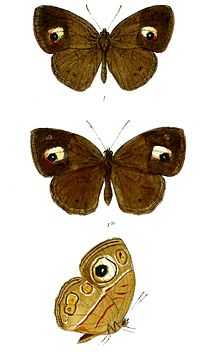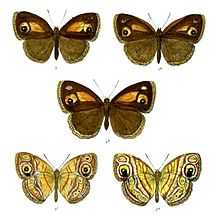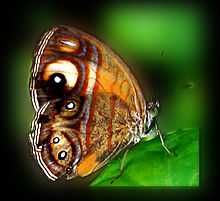Mycalesis patnia
| Gladeye Bushbrown | |
|---|---|
 | |
| Scientific classification | |
| Kingdom: | Animalia |
| Phylum: | Arthropoda |
| Class: | Insecta |
| Order: | Lepidoptera |
| Family: | Nymphalidae |
| Genus: | Mycalesis |
| Species: | M. patnia |
| Binomial name | |
| Mycalesis patnia (Moore, 1857)[1] | |
The Gladeye Bushbrown (Mycalesis patnia) is a satyrid butterfly found in southern India and Sri Lanka.
Description

- See glossary for terms used
Upperside: Male has a dark-umber-brown ground-colour slightly suffused with ochraceous. Fore and hind wings with bright ochraceous-yeilow, slender sub-terminal and terminal lines; cilia pale brown. Fore wing with a large median and a much smaller subapical white-centred black ocellus, each with an orange-yellow iris, the upper portion of the iris round the median ocellus very broad, the lower incomplete and a more or less triangular orange-yellow discal patch. Hind wing uniform, with two very small fulvous-ringed black ocelli.

Underside of male deep ochraceous yellow, subterminal and terminal line as on the upperside ; fore and hind wing crossed near base by a darker ochraceous-yellow line, followed by a silvery discal band, beyond which there are two ocelli as on the upperside, but each encircled also by an outer silvery ring; and on the hind wing a curved series of seven similar ocelli having a silvery band bordering them on both sides, the third and fourth ocelli from tornus together and the apical ocellus by itself placed on a brighter ochraceous patch encircled with black. Antennae, head, thorax and abdomen brown, somewhat ochraceous beneath. Sex-mark is present in one morph.
Female is similar to the male but more strongly suffused with ochraceous on the upperside; the orange-yellow patch on the fore wing larger, spreading to the base of the wing and no ocelli on the hind wing. Underside as in the male, but of a brighter ochraceous yellow; basal area of both fore and hind wing crossed by two darker yellow bands, and the discoidal cell of the fore wing with an interior loop of the same colour.[2]
The South Indian race M. p. junonia is identical to the nominate race from Sri Lanka but on the upperside is a duller brown colour; the median ocellus on the fore wing encircled with pure white ; no discal patch, or merely faint traces of one. Underside: markings similar to those in M. p. patnia, but altogether of a duller and browner shade, without any general ochraceous tint, a large bright ochraceous spot posteriorly on the hind wing in the male. The median ocellus on the fore wing broadly encircled with white. Male sex-marks are seen in one morph.[2]
It has a wing expanse of 42–54 mm.
References
- ↑ Moore, Frederic 1857; in Horsfield & Moore, Cat. lep. Ins. Mus. East India Coy (1): 232
- ↑ 2.0 2.1 Bingham, C. T. (1905) The Fauna of British India, Including Ceylon and Burma. Butterflies Vol. 1
